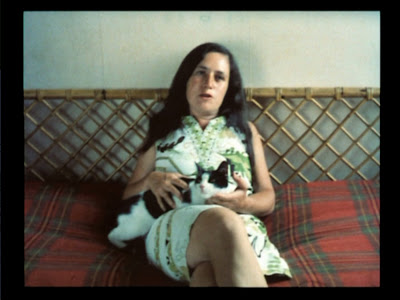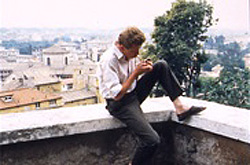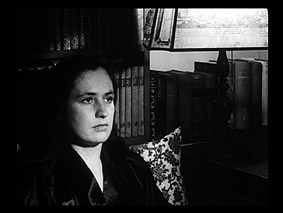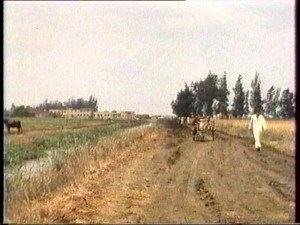Written for a tribute to Danièle Huillet in Undercurrent, on the FIPRESCI web site, in March 2006. — J.R.
One thing worth mentioning about Danièle: I’ve never known anyone who knew her and Jean-Marie well enough to know absolutely for sure whether or not they were literally husband and wife. This might strike some as a mere technicality, but I think it signifies something more. Whether they went through an actual wedding ceremony or wound up living together; whether they considered having children; whether it was inaccurate or precise, impolite or perfectly okay to refer to them as “the Straubs”: these are all basically questions about how they defined themselves in relation to society. And the fact that most of us don’t know the answers points towards a larger uncertainty about whether they were true bohemians or eccentric traditionalists (not necessarily the same thing), or some combination of the two. (Danièle only began to be credited as coauteur belatedly, after their first few films. But was this because she gradually became more active as a filmmaker or because the two of them began to place a higher value on her participation? Again, I have no idea.)
I think the fact that their work provokes silence more often than discussion — a tribute in some ways to its continuing radicality and difference — may be partly to blame for this. The same sort of syndrome was responsible for magazines like Screen reproducing some of their scripts at the same time that they chickened out of grappling with any of their films critically. But it’s also worth remarking that part of the strength and value of their work has always been tied to the way it goads us into asking such impertinent, materialist questions, regardless of whether or not we accept the challenge of answering.
Exhibit #1: A public discussion with Danièle and J-M at the Edinburgh Film Festival, August 27, 1975, mainly about Moses and Aaron (1974) and Introduction to the Accompaniment to a Cinematographic Scene by Arnold Schönberg (1972) — recorded by Peter Gidal and published in Ark: The Journal of the Royal College of Art (No. 1/52, Spring 1976). Considering how scarce this text is today, and how interesting its account of Jean-Marie filming Danièle is, I hope I can be excused for transcribing this lengthy exchange, which begins with a question that I intended partially as a provocation:
JR: One last question of a different sort involving your short on Schönberg. This may sound like a frivolous question but it’s meant seriously. In all your films but particularly in this short I feel that each detail, each element carries a great deal of weight, both dramatically and in terms of the meaning of the images. And I was wondering if you could comment on two specific things in the film: one is your [J-M’s] lighting of a cigarette, and the other is the cat.

JMS: I can tell you about the screen in Accompaniment to a Cinematographic Scene, which is behind me when I’m reading Schönberg’s letters. I wanted to have the screen because I wanted the audience to have the impression that on the screen newsreels would be projected. But the cigarette was because the film had been envisaged without the stone figure of the fountain. It was to begin with me. But as the film was commissioned by the third channel of German TV… the Germans had two films, one made by Jan Mortensen, a Swedish musician, another by a young French musician named Luc Ferrari, two very different films (from ours), absolutely apolitical.
DH: On the same piece of music.
JMS: We had an agreement, our film would be shown last, if it was shown at all, because there was a risk that it would not be. But if it hadn’t been, well we had the negative, we’d made the film and we could have shown it somewhere else. The beginning had to be a rest for the audience and because I couldn’t just stay like that, I lit up a cigarette. But after the fountain shot was added we left it like that because to go straight into the reading would have meant there would have been no breathing space.
The cat, that’s a bit more complicated. It’s a cat we had at home. We found it three years before, starving on the street. The vet said it had to be put down at once. It had no hair left, it had rabies and every other disease imaginable, it was undernourished, it walked like this [gestures with his hands]. Now it’s beautiful. The cat is part of Danièle because without her it would have died, since it was isolated from other cats, because its illness was contagious and people didn’t bother with it, precisely because it was sick. Apart from that, I was beginning to have an immense problem, almost of the class struggle. I think there is a reflection to be made from this standpoint, and it’s been going on for centuries, like the other. Obviously it will need centuries to solve it…and I believe it is important, really important. But what did you feel about the cat, to ask another frivolous question?
JR: It was a chance element, whereas everything else was in a sense pre-set, it’s that you couldn’t completely control what the cat was doing.
DH: It was very afraid, not of the camera, but of the microphone.
JR: It sounds like a contradiction, but I like it….
JMS: Besides, it’s an elementary device when you have one who is not an actor to have something which distracts him. Renoir does it better than anyone, and Brecht too for that matter…. Moreover, I think it is very important since it was a very terrorist text, to have an alien element…. There is the terrorist direction vis-à-vis Schönberg, and even vis-à-vis the audience, but at the same time there is an element of tenderness. There is a third pole, not just one, two, but one, two, three, because of the cat.
For the first time…. For ten years I have been trying to film someone facing the camera and I’ve never succeeded. It always angers me in Godard’s films to see people photographed facing the camera. I told myself, I’ll do it one day and I’ll do it differently. And they don’t look as if they’re photographed facing the camera. I wanted to do it and at the same time I didn’t agree with it. And I found a way there, precisely thanks to the cat, which is a third element. Because from the framing you don’t know if the camera’s looking at the cat or the person.
And now the final frivolous answer. The cat was a bit Chinese, the black and white pattern is a bit Chinese and brings us back to Brecht who was interested in Chinese painting. It also has a relationship to the dress Danièle was wearing, one she’d had about ten years but we chose it deliberately from three others.
Exhibit #2: A 1976 postcard written to me, Yehuda Safran, Tony Rayns, and the late Jill Forbes by Danièle, sent on 14 March from Rome (and one whose signature incidentally suggests a kind of response to my opening query). It was prompted by the March 1976 issue (vol. 43, no. 506) of Monthly Film Bulletin, containing our reviews of four of their films and a back-cover feature (the first of many hundred MFB back-cover features) that I’d prepared as assistant editor — a multilingual bibliography of their interviews, scripts, and other texts: “Thank you for your reviews — but why, why are the most important technicians always missing in the credits? That is, the sound recordists!?! This is something which has to be changed: a good sound recordist has to work with more precision, more hability, and more imagination and experience than the best cameraman. There is no film without images — but there are no films from us (and some others) without sounds….Cari saluti, Danièle Straub-Huillet”
I no longer have a copy of my response to her, which explained that in fact we had included all the sound credits of all four films. But I still cringe a bit when I look at the headline for the bibliography — “Jean-Marie Straub and Danièle Huillet,” with the last three words in smaller typeface — according to our priorities as they were correctly perceived by our layout person.
Exhibit #3: This was only five years after Richard Roud’s Straub — a book that doesn’t credit her as codirector on anything, not even Othon (1969). But when I and many others subsequently made various stabs at guessing what she and J-M brought separately to their collaboration, I’m brought to my third and final exhibit — a 20-page, tabloid-size catalog, a collection of texts I assembled and introduced for the last full Straub-Huillet retrospective held to date in the U.S., which I curated at Manhattan’s Public Theater, November 1-14, 1982, along with their selection of 15 films by others, 11 of which we managed to program as well. (Many of their groupings were inspired: Othon + Every Revolution is a Throw of the Dice + A King in New York; History Lessons + The Bridegroom, The Comedienne, and the Pimp + A Corner in Wheat + Land without Bread + John Ford’s The Civil War in How the West Was Won; Fortini-Cani + This Land is Mine. And the program culminated in a triple bill of From the Cloud to the Resistance + Tale of the Late Chrysanthemums + the English-dubbed version — now finally available on DVD — of Luc Moullet’s Une Aventure de Billy le Kid.)
The retrospective and accompanying publication was the only occasion in which I worked with Jean-Marie and Danièle and learned something direct about their painstaking and scrupulous precision. The project came in three stages: a lengthy brunch in New York with Fabiano Canosa and them in early May 1982 (yielding a handwritten list from Danièle of titles and directors that I still possess–-including, opposite This Land is Mine, “Renoir [Laughton!]”; a huge package of photocopied reviews of their films (mostly in French) with an accompanying letter from her, sent from Europe later the same month (and which I can no longer find, at least while writing this); and the public discussions with them that I moderated before and after some of their programs in November, during which a surprising number of her contributions consisted of her glossing his remarks. The articles I included in the publication at their instigation were English translations of Luc Moullet’s “Film is Only a Reflection of the Class Struggle” (by Sandy Flitterman) and Serge Daney’s “Cinemeteorology” (by me), Gilberto Perez’s “Modernist Cinema: The History Lessons of Straub and Huillet,” and my own article “Transcendental Cuisine” (written for but rejected by Soho News). The latter was a review of From the Cloud to the Resistance (1979), which I’d seen in a class at New York University, abruptly interrupted by reviews of Zorro, The Gay Blade and Heart to Heart, which were playing commercially in New York the same week. (Soho News published only the latter two reviews; after I submitted the same article as part of a chapter in my book Film: The Front Line 1983, my publisher insisted on running only the portions about From the Cloud to the Resistance. So to date, the only publication of the full article has been in this catalog.)
As for “Cinemeteorology,” Daney’s review of Too Early, Too Late (1982) in Libération, this was part of the package Danièle sent from Europe. And she added a caveat to Serge’s reference to “the Straubs, city inhabitants”: “Jean-Marie is a Stadtkind [city-child]. But I grew up in the country, though born in Paris…” This reminds me of a suggestion once made to me in the early 1980s by filmmaker Sara Driver: that Too Early, Too Late may be more Huillet’s film than Straub’s, reflecting her rural background, just as En Rachâchant, made the same year, may be more his than hers. It’s a speculation, of course, but I still happen to believe it’s true.
![]()
And for whatever it’s worth, my favorite Straub-Huillet films are Too Early, Too Late and Operai, contadini (2001), both color landscape films with especially acute senses of place as well as of nature in all its harsh beauty. And it’s worth recalling that the first Straub-Huillet film that the New York Film Festival failed to show, their sixth, was Fortini/Cani (1976), another color landscape film — apparently rejected because the festival organizers feared demonstrations from the Jewish Defense League due to its pro-Palestinian text. I’m bringing all this up because I was extremely touched when Dave Kehr managed to persuade the New York Times to run a Huillet obituary on October 12, which he hastily wrote himself, even though I was chagrined that he wrote that their films were shot “most often in black and white” — an understandable lapse given how few of their 16 color (as opposed to their six black and white) films ever showed in the U.S. Much more apt was Kehr’s remark that the “famously combative…Mr. Straub enjoyed playing bad cop at festival press conferences to Ms. Huillet’s softer, more conciliatory personality” — though some of the evidence available from Pedro Costa’s exquisite 2001 documentary about them, Où gît votre sourire enfoui?, as well as some of my own encounters with them, suggested that in slightly less public situations they were also sometimes capable of exchanging those roles. (It’s a telling sign of the current chaos of our film culture that the Times ran Kehr’s otherwise mainly well-informed obituary at the same time that it was ignoring most of the ongoing New York Film Festival, meanwhile steadfastly and indiscriminately reviewing all the studio films that were playing commercially.)
At the funeral of Lubitsch, one of the favorite filmmakers of Jean-Marie and Danièle, William Wyler reportedly said to Billy Wilder, “Well, no more Lubitsch,” to which Billy Wilder reportedly replied, “Worse — no more Lubitsch films.” As I lament the absence of any more Straub-Huillet films, I regret in particular the absence of any in the English language. It’s quite possible, of course, that none would ever have materialized even if Danièle had lived another three decades. But I’m still tantalized by Pedro Costa having told me in Buenos Aires in 2004 that they were spending much of their free time translating plays by Shakespeare into Italian — simply for the sake of doing so, because they were so unhappy with the existing translations. Let’s all try to imagine a Straub-Huillet rendition of a Shakespeare play in defamiliarized — that is to say, reinvented — English, placed in a lush English countryside. As Hamlet himself would put it, “’tis a consummation/Devoutly to be wished.”





